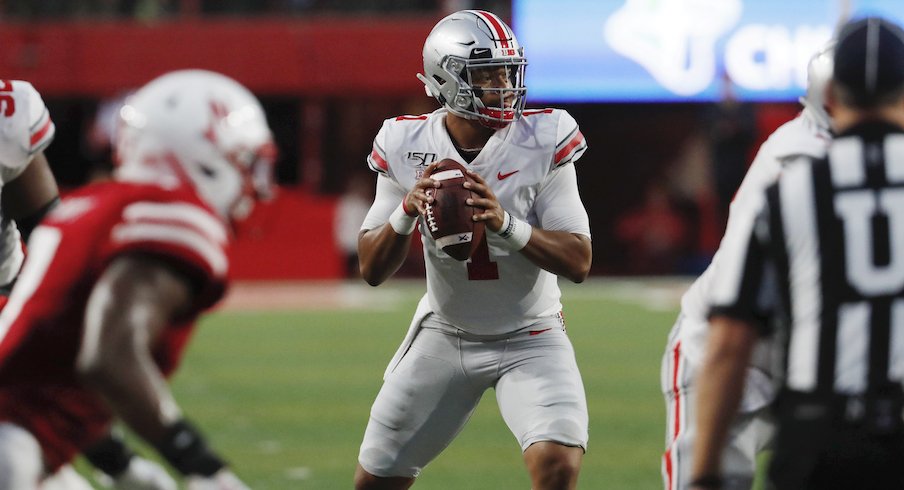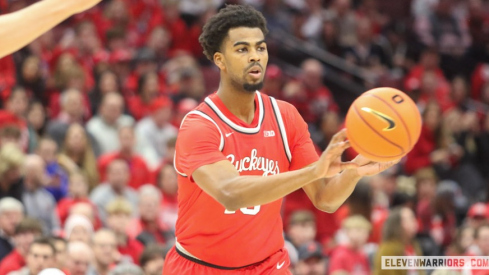LINCOLN, Neb. – In the first five games of 2018, a historic offensive season, Ohio State racked up 245 points.
Five games into the 2019 season, the Buckeyes already have scored 262 points. In every victory, including the 48-7 win against Nebraska on Saturday, they've compiled more than 40 points. The rapid ascension of Justin Fields has, of course, played a major role in the early season success.
Fields completed 15-of-21 passes for 212 yards and three touchdowns, adding 12 rushes for 72 yards and a touchdown on the ground. Still, he hasn't thrown an interception this season.
“Coach Day told me right from the get-go, and so did Dwayne,” Fields said. “This offense is a great offense, and I feel like it fits me well. We have a great passing game, great running game. I think the offense is just great on really, really all things.”
On Saturday, the Buckeyes managed 580 total yards, averaging 9.6 yards per passing attempt and 6.9 yards per rush.
In the balanced attack, three players – Fields, J.K. Dobbins and Master Teague – averaged at least six yards per carry with more than 70 rushing yards. Garrett Wilson, K.J. Hill and Austin Mack each caught touchdown passes.
So, was this Ohio State's best offensive performance yet? Ryan Day wasn't quite willing to go there.
“I don’t know,” Day said. “We’ll watch the film and see, it’s never as good or as bad as you think until you watch it on film. But I’m proud of the way the guys came out here and played hard. They stepped right in, and we talked about it all week, what it was going to take to win this game on the road. We kind of came in hitting on all cylinders. I thought we tackled well on defense, created some turnovers again, created a short field and we ran the ball. That was great to see, I thought the line did a good job, the backs ran hard, and Justin (Fields) made some really big-time throws. And when you combine that together with good special teams, I’m proud of the way the guys played.”
One of those "big-time" throws from Fields came on a six-yard touchdown toss to Wilson.
However, Fields describes it as if it's anything but a "big-time" connection.
“We do so much work in practice, that was just a routine play for us,” Fields said. “I like the mismatch on Garrett, and I thought he was way better than the corner that was on him. So I just went up to Garrett and it just happened like we practice, for real. Really nothing else. It was just a routine play.”
That touchdown, which came with 3:51 remaining in the third quarter, represented the final points the Buckeyes managed on Saturday.
The score didn't lead to Fields coming out of the game, though. At that time, Ohio State held a clearly insurmountable 48-0 lead. But when the team's offense returned to the field with 1:56 remaining in the third quarter, Fields stayed in the game for one more drive, which dragged into the fourth quarter.
“They’re a great team,” Day said. “They’re no-huddle and they can strike at any time, it’s a good offense. I just wasn’t sure at that time where the game was going. They came down and scored, Chase (Young) was out of the game. That was a tough decision to make but we decided, maybe one more drive to keep those guys in there and be smart. You look back and sometimes you can second guess yourself, but that was the decision we made at the time.”
Ohio State's protection of Fields likely eased Day's mind a bit.
Mohamed Barry, a Nebraska linebacker, certainly noticed the strong offensive line play. After the game when asked to compare this season's line to what he faced last year, Barry had a clear answer.
“I can’t even begin to compare the two,” Barry said. “It was way different. They’re hungry. You can respect that as a competitor. Real hungry to get up and single block the linebackers. That was a pretty good line.“
Josh Myers, Ohio State's first-year center, played his first-ever game in Lincoln, Nebraska, and it came under the lights. Darrion Daniels, a senior defensive tackle for Nebraska, sees a bright future for the redshirt sophomore.
“He is a big boy, a big body,” Daniels said. “I think I remember hearing he was a converted guard, so he was a guard and moved over to center, so he’s bigger than a majority of the guards I’ve seen. He can move pretty good laterally. I know he’s young but he’s going to bring some problems for somebody later on.”
The Buckeyes never appeared anywhere close to falling victim to an upset. They ended the first quarter with a 14-0 lead and headed to the locker room at the half with a 38-0 advantage.
The Cornhuskers admitted, though, that they had some optimism about a possible win.
“We’re all disappointed,” Scott Frost said. “I thought we had a puncher’s chance if we came out and played a really good game, and we didn’t, so that’s the result.”
“They are number five for a reason,” Daniels said. “I think we’re a good team too. I know we’re a good team too. We could have played a better game. They played a really good game, they were more consistent than we were and that’s what wins games now, not just big plays, but consistency on all three phases of the game. And they were more consistent than we were, which is why the outcome was the way it was.”
The biggest scare Nebraska put into Ohio State came when it decided to go into an I-formation on offense, catching the Buckeyes by surprise. Of course, that ended with Ryan Day calling a timeout and Jeff Okudah intercepting a pass soon thereafter.
“That drive, we kind of went back to some old school Nebraska stuff and it worked and we drove it down the field, had an opportunity on a pass play and if we’d given the quarterback a little more time it probably would’ve been a completion and a touchdown,” Frost said. “He was hurried a little and had to float it and we got a bad break. I think our guys executed that stuff pretty well and that was neat to see.”
With the Cornhuskers having not shown that formation in the first four games of the season, the Buckeyes had to scramble to regroup. A timeout led to reminders of offseason preparation for that type of defense, and that led to Nebraska turning away from the under-center look.
“You can't chase ghosts, but you have to kind of say, 'OK, they could do this. They could do that,’” Mattison said.
“You used to always practice against I-backs, and you used to practice against that,” Mattison said. “Well, nobody runs it. Zero people. And we had this discussion early in the fall, and we did it in the spring. But we haven't touched it since then, and all we had to do it sit everybody down and say, 'Remember, here's how we're going to handle this. Here's what we'll do.' And our guys do.”
“Smart guys who trust us and pay attention,” Hafley said. “The fact that they can adjust that fast is awesome. It's a credit to the players because, again, we hadn't seen it. Hadn't practiced it. Good game plan for them. That was a good, tough series, that drive. And then maybe they saw that we settled in and they got away from it. Plus, at that point too, I don't think it was going to become a two-back run game. We were up. The offense did a great job.”
Once Nebraska opted to return to Frost's typical offense, Ohio State's defense once again reigned.
The Cornhuskers averaged just 2.8 yards per passing attempt and 4.7 yards per rush, giving a glimpse at what the Buckeyes look like against a faster-than-average team.
“I think we're a defense that's very talented,” Mattison said. “I think we're a defense that believes in each other, believes in the system, believes in what we're trying to do. And I think we're a defense that knows they have to work hard every week to get better. You get around defenses, sometimes they don't see that as they go on. Our guys understand that we can get better. We can get so much better, and we've just got to do that every week.”


